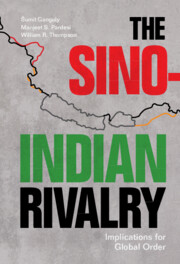Book contents
- The Sino-Indian Rivalry
- The Sino-Indian Rivalry
- Copyright page
- Contents
- Figures and Maps
- Tables
- Acknowledgments
- Part I Introduction
- Part II Spatial and Positional Considerations and Violence
- Chapter 3 The Sino-Indian Rivalry The Positional Dimension (1940s–1950s)
- Chapter 4 Positional Issues and the 1962 Sino-Indian War
- Part III The Evolution of the Rivalry
- Part IV Interconnected Rivalries and Systemic Considerations
- Part V Conclusion
- Bibliography
- Index
Chapter 4 - Positional Issues and the 1962 Sino-Indian War
from Part II - Spatial and Positional Considerations and Violence
Published online by Cambridge University Press: 15 June 2023
- The Sino-Indian Rivalry
- The Sino-Indian Rivalry
- Copyright page
- Contents
- Figures and Maps
- Tables
- Acknowledgments
- Part I Introduction
- Part II Spatial and Positional Considerations and Violence
- Chapter 3 The Sino-Indian Rivalry The Positional Dimension (1940s–1950s)
- Chapter 4 Positional Issues and the 1962 Sino-Indian War
- Part III The Evolution of the Rivalry
- Part IV Interconnected Rivalries and Systemic Considerations
- Part V Conclusion
- Bibliography
- Index
Summary
The 1962 Sino-Indian War was not just a border war over disputed territory (or the outcome of the Sino-Indian spatial rivalry alone) as is generally argued because issues related to their positional rivalry were also at stake. Sino-Indian positional rivalry in the Himalayan states and in Burma was linked with the Tibetan issue, and Tibet itself was at the nexus of Sino-Indian spatial and positional rivalries. Furthermore, the 1962 Sino-Indian War proceeded as wars between positional rivals tend to: with the near multilateralization of the war as India sought help from the United States (and that it was favorably considered). While China’s unilateral ceasefire that was accepted by India precluded overt American participation, India’s massive defeat also had positional consequences as it removed India as a contender for Asian leadership. Although this did not result in Chinese leadership in Asia, China continued to remain more important than India to the wider Asian strategic dynamic in the decades after 1962.
Keywords
- Type
- Chapter
- Information
- The Sino-Indian RivalryImplications for Global Order, pp. 75 - 104Publisher: Cambridge University PressPrint publication year: 2023

